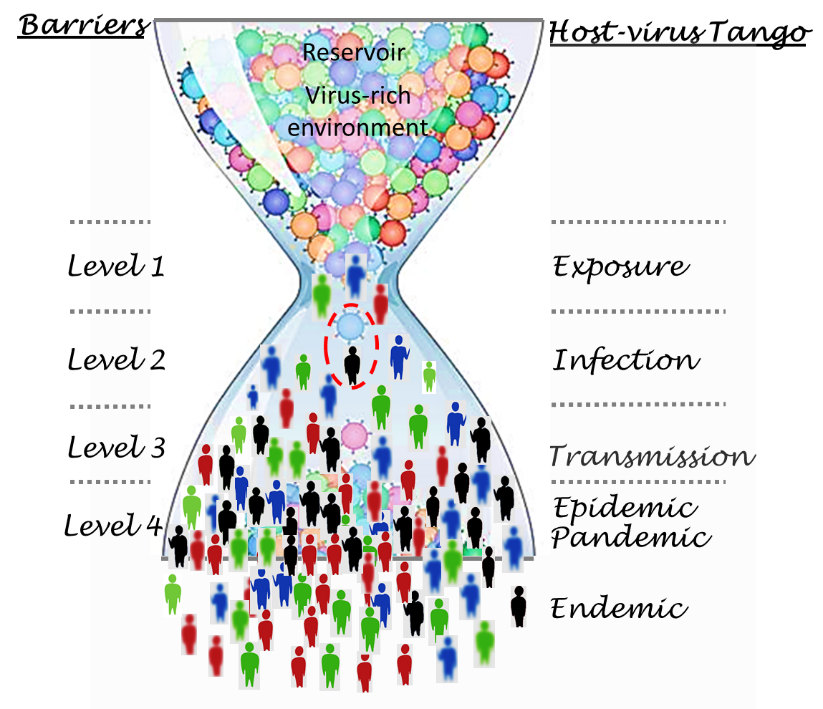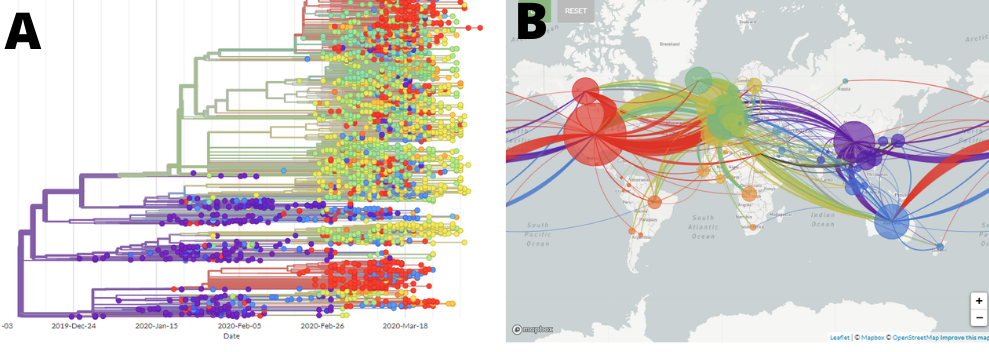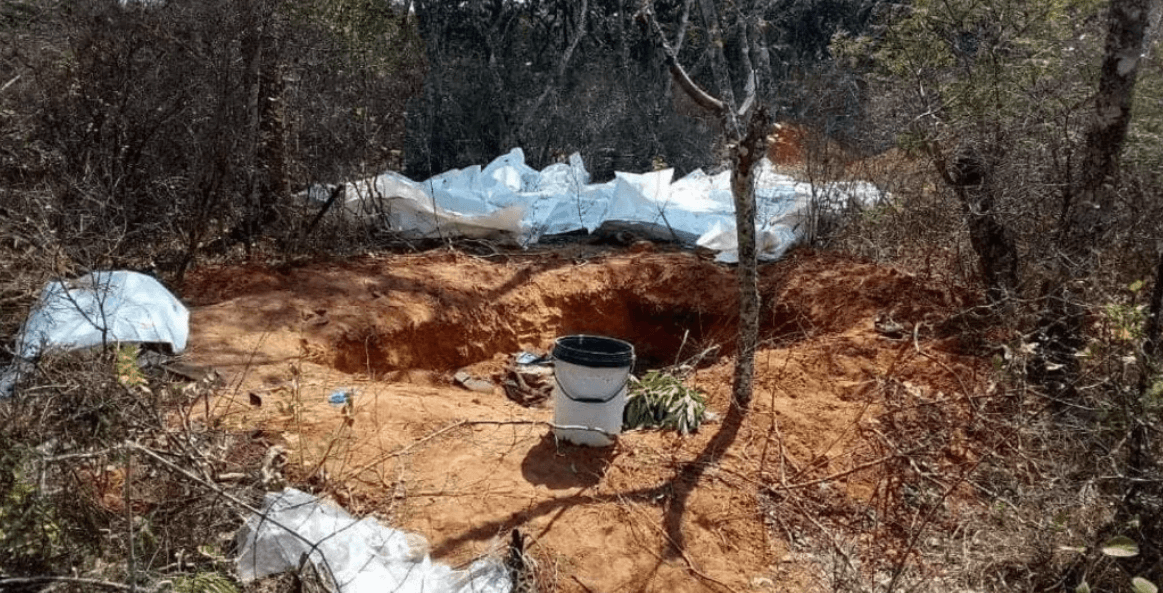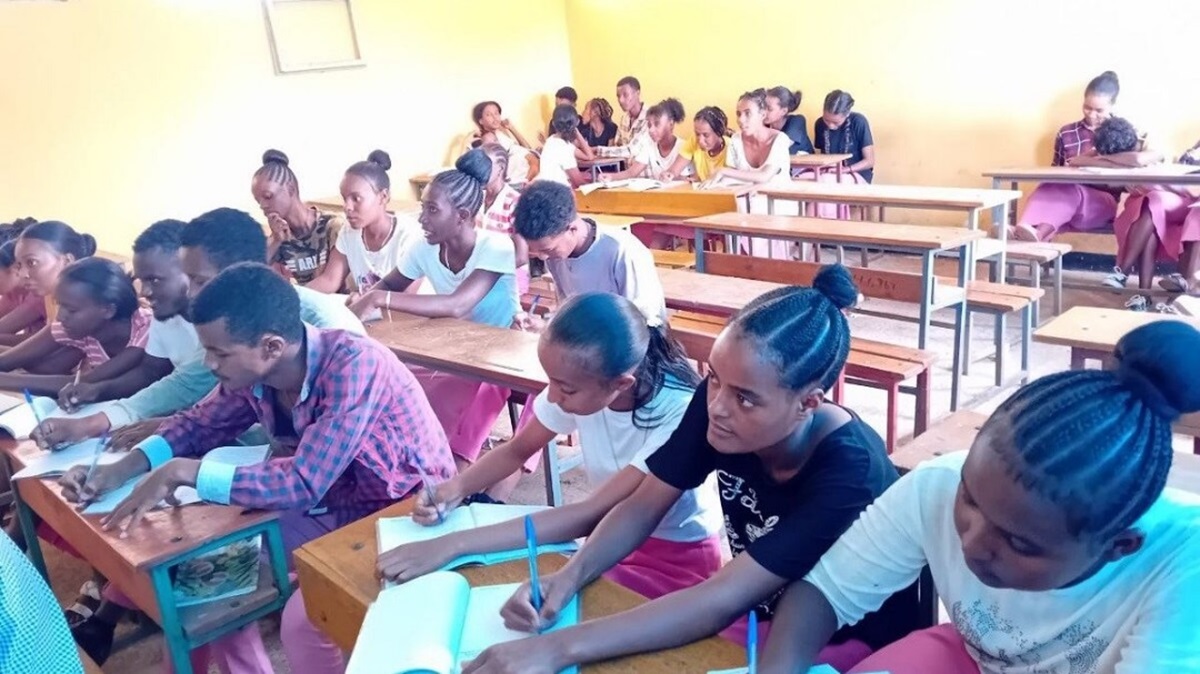Analysis: The human-coronavirus molecular dance: It takes two to tango

Belete A. Desimmie @adbelete, (MD,PhD),FitsumTilahum @fitse_t (MD) &
Ermias Kacha @ErmiasMd (MD)
A World of Relentless Viral Threats
Addis Abeba, April 27/2020 – Viruses are the most mysterious and tiniest lifeforms; none of them survive without a host and hence referred to as ‘organisms at the edge of life’. Most of us, if asked about viruses, we tend to describe them as deadly pathogens that cause a broad array of illnesses such as AIDS, Ebola, the flu, and now COVID-19.
However, we also started to appreciate that our body is home to diverse commensal viruses – collectively called the human virome. Humans and viruses coexisted since the beginning of life and are constantly interacting. The molecular dance between them takes two to tango. In fact, their marriage can be symbolically described by the famous French song lyric “Je t’aime…moi non plus” written by Serge Gainsbourg. It means “I love you… me neither“.
‘Germ-hunting’ requires technology and a solid grasp on the functions of the building blocks of these lifeforms. Since the discovery of the first human virus (yellow fever virus) in 1901, we continued to have three to four new virus species per year. To date, over 400 virus species had compelling evidence to spillover from nonhuman vertebrates to humans. Viruses make up over two-third of all emerging human infectious diseases compared to the other pathogens combined – bacteria, parasites, and fungi. It is inevitable that novel human viruses will continue to cross species barriers and cause outbreaks. COVID-19 shocked the world nothing like it before since the “Spanish Flu’ in 1918.
We practiced for pandemics many times, but we continued to appallingly fail to brace them and respond to the accumulating evidences. This calamity was emphatically exposed by COVID-19, which did not spare a single nation on earth. Some politicians tried to garner the social license to prepare for this disaster that people see as unlikely and far from their daily lives. Unfortunately, others, including the most powerful leaders, were disruptive and at best dismissive – leaving the whole world in limbo. As it has been said many times, viruses do not have borders. COVID-19 should be the ultimate wake-up call to bring us humans together to prepare us better for future pandemics by making systemic changes to rebuild (reinvent) our surveillance strategies to be more resilient on a global scale. Our long-term priority should be to identify high-risk viruses prior to their emergence even if we can never be sure when or from where something like COVID-19 would come.
Predicting the emergence of novel human viruses is one of the most challenging and critical areas in the public health arena. The cross-species barrier exists but it is very leaky. The human-virus interaction is illustrated by the inverted (‘kissing’) pyramids in Figure 1; a useful conceptual framework to understand the evolutionary profile of emerging human viruses such as SARS-CoV-2.

Figure 1. Emerging human virus evolution illustration pyramid. Each level represents a different degree of host-virus interactions and barriers. Some viruses can evolve and gain function to cross species (the dotted red oval) and progress to the next level and so on. This interspecies spillover could take from few years to decades for emerging human viruses due to multifaceted and complex eco-biological barriers (Level 1; the neck). (Template from Attar N. Nat Rev Micro, 2015)
Level 1 (Exposure): Humans are frequently exposed to many viruses from the environment and the rate of exposure depends on a combination of the ecological distribution of the nonhuman virus-rich reservoirs and humans’ activities. It is difficult to detect viruses that humans are exposed to, which are almost always shrouded in a distant past. However, a few viruses that emerged in human from reservoirs could evolve in intermediate hosts or directly infect humans. Refining our surveillance strategies to regularly sample the environment to identify potential emerging viral threats should be given the utmost priority.
Level 2 (Infection): Once the virus overcomes the species barriers and infects humans, its gain-of-function will be further optimized through extensive parallel substitution and recombination events at its genome level. Viruses evolve, adapt, and sabotage our cellular machineries to evade the relentless host of immune surveillance and pressure. An analytical technique called metagenomics – an advanced technique that analyzes ideally of all (‘meta-‘) microbial genomes (‘-genomics’) in a sample – can identify the exact invading organism even in the absence of any ancestral footprint.
Level 3 (Transmission): Here the founder virus multiplies in the body of the early infected individuals (index cases) and then exits via different routes, including but not limited to respiratory droplets, bodily contacts, blood, or other secretions to infect new (secondary) hosts. The genetic code that defines these viruses will continue to be partially lost, gained, or merely revised during the virus-host arms race. By doing so, viruses give up their secrets by accumulating one mutation at a time. And detection of such molecular fossil via genomic analysis allows scientists to determine the spreading pattern of any emerging viruses; insights that were not possible in the past.
The Chinese scientists carried out a metagenomic analysis on samples obtained from five pneumonia patients in Wuhan, China. They were able to identify and reconstruct the full-length of novel coronavirus genome; the virus and the disease were later named SARS-CoV-2 and COVID-19, respectively.
Zoonotic coronaviruses have caused three large-scale outbreaks – SARS, MERS, and COVID-19 – in the past two decades. To date, well over 200 distinct coronavirus species have been identified in the coronavirus-rich bat reservoirs by Chinese scientists. This number is minuscule compared to the estimated (>5,000) coronavirus species circulating in different bat species. If we fail to develop universal (family-specific) vaccines or make a significant system change in our surveillance strategies as soon as possible, it is very likely that another novel coronavirus will emerge in humans in the foreseeable future.
Level 4 (Epidemic/Pandemic): At this level, viruses can sufficiently spread between humans and cause major outbreaks (epidemic/pandemic) by circulating in the human populations without requiring non-human hosts. Epidemiologists quantify this phenomenon by calculating the reproduction ratio (R0), which informs us about the average number of secondary cases generated by a single primary case at each node in the transmission tree. R0 is a function of both the infectiousness of the virus and the demography and behavior of humans. For example, the #SocialDistancing and #StayAtHome campaigns have significantly contributed to flatten the curve of COVID-19 in some nations by directly affecting the R0 of SARS-CoV-2.
One may ask that why three novel coronaviruses emerged and caused large-scale outbreaks in less than two decades. This issue has become a hotcake for misinformation and all kinds of conspiracies. However, the most straightforward explanations are: the capability of these coronaviruses to evolve rapidly; the efficiency of respiratory viruses to spread between humans via respiratory droplets and contacts; and the human behavior and the frequent interactions of humans with exotic coronavirus-rich animals.
Disease Detectives’ Tool: Connecting the Dots Using Phylodynamic Analysis
Until recently, ‘germ-hunting’ has been a labor-intensive process using an epidemiological technique that rely on the verbal autopsies of index case and contact tracing. Epidemiology is the science of aggregation as its name implies. It is derived from two Greek words “epi” (“upon”) and “demos” (“the people”). Contact tracing is an imperfect process but can be used to plot a time-stamped map of the germ’s spread using data from ill, dead, and recovered individuals. Inference about the route of transmission, disease spectrum, and potential mitigation measures that slowed the novel pathogen spread can then be made. Having said that, epidemiology works most effectively when applied with the science of the one, medicine.
Genomics, a true example of the science of the one, allowed scientists to follow the progression of mutations from patient to patient. It is key to investigate emerging viruses and clarify how the virus’ genetics modulated by host immunity, transmission bottlenecks, and epidemic dynamics determine the viral quasispecies within an infected individual specifically and the population at large. A framework that captures this evolutionary profile is called phylodynamic, which allows us to search for the needles through haystacks of DNA or RNA sequences of specimens from patients. By stacking gazillions of sequences on top of each other, we now can pinpoint the changes in the genetic code of the virus at a single letter precision and reconstruct phylogenetic tree – a “tree” of viral descent as shown for the global subsamples of SARS-CoV-2 in Figure 3; this is possible only because of the power of computing. Imagine if you were tasked to manually identify an error in a single word from close to 800, 000 words of the holy book, the bible.

Figure 3: Global genomic epidemiology of SARS-CoV-2. (A) Evolutionary divergence SARS-CoV-2 genome (Y-axis). Each line is a single sequence. (B) The global transmission patterns. China (purple); Europe (green; N. America (red); Australia (blue); S. America and Africa (orange). Data accessed from https://nextstrain.org/ncov/global (15/4 2020).
By looking at the common ancestor of SARS-CoV-2, we now know that the earliest human cases were from Wuhan, China and its proximal origin is a bat coronavirus. However, we do not know the specific bat coronavirus species that spilled over to human. We also do not definitively know if there is an intermediate host like pangolins; extensive research is underway to address these questions. But it is important to note that both SARS (in 2003) and MERS (in 2012) coronaviruses ancestors were also originated from bats, which diverged by about 17 and 8 years, respectively. Similarly, there is a new preprint report suggesting that SARS-CoV-2 arose from a bat coronavirus with a divergence date estimated to be 40-70 years. If this holds true, there are several critical questions to be addressed: why did the lineages of these highly related coronaviruses took variable times to emerge in humans? What factors derived the latest coronavirus, SARS-CoV-2, spillover to human, which is the most divergent with peculiar pathogenicity features? What is the intermediate host for SARS-CoV-2, if there is any?
We will leave these questions to be addressed by the disease detective geneticists. However, the emergence of bats coronaviruses that caused three significant pandemics in human within 17 years coupled with the coronavirus-richness of bats imply that a new epidemic is likely to happen again. Now, we have practiced for coronaviruses pandemics at least three time and it is time to brace them and develop a resilient global surveillance strategy.
Combining comparative genomics with old-fashion epidemiological profiling of emerging viral diseases, including HIV, SARS, MERS, Ebola, Zika and several others has given us a rare glimpse of viral evolutionary biology in real time with an astonishing clarity. Scientists are working day and night to garner the same evolutionary profile for COVID-19. Detailed analysis of the branches of the phylogenetic trees of SARS-CoV-2, similar to the one shown in Figure 3, will allow us to gather insights into the spatiotemporal transmission patterns and its magnitude worldwide. The recently deposited SARS-CoV-2 sequences are getting slowly but increasingly diverse. The limited accumulation of mutations is an unusual and a very striking feature for an RNA virus that has a genome size of about 30,000 nucleotides. Yes, every virus has its own personality, and similar patterns have been observed with other viruses, too. Even a single mutation could be consequential either by increasing viral fitness or spelling its demise. And, for viruses, this is not surprising either.
As the COVID-19 cyclone continues worldwide, we have begun to get some quantitative answers to several questions, including how exposure intensity and viral loads relate to the peculiar clinical course of COVID-19 and transmission patterns. The upcoming molecular and epidemiological data will continue supplement the bird’s-eye view with the worm’s-eye view. Understanding the human-SARS-CoV-2 molecular dance and the function of the virus-encoded recipes i.e. the viral proteins will be very critical in developing diagnostics, effective therapeutics, and protective vaccines. How these insights will change the way we manage our patients and stop its spread during the current pandemic?
As in most emerging infectious diseases, this can only be viewed in a rearview mirror. By the time we are ready with effective therapeutics and vaccines, it is very possible that the current wave has fizzled out. Nonetheless, we cannot deny the scientists effort on the rate of record-breaking discoveries, the number of drugs and vaccines being discovered and fast-tracked at this critical juncture.
The COVID-19 code: A string of RNA
In general, the genetic code of viruses comes in two flavors: some are DNA (a double-stranded string of letters) viruses and others are RNA (a single-stranded string of letters) viruses. SARS-CoV-2 that causes COVID-19 belongs to the latter category.
The genome of SARS-CoV-2 is about 30,000 nucleotides long RNA string (Figure 3), which is ~100,000X smaller than the human DNA genome. The virus conceals the bad news in its RNA that is wrapped in few proteins, which are encased in a highly fragile microscopic spikey lipid blob as shown below (Figure 3). A combination of concerted efforts has really gotten us a much fuller version of the puzzle of COVID-19 in a record short period of time. Decoding the genomic RNA informed us the secrets of the virus past, including its origin. It also allowed us to make sense of the functions of most of the 29 proteins that the virus owns. The choreography of the molecular dance between the host and viral proteins in the infected cells is very elaborate, and for virologist like me it is an enthralling chess game.
Previous research on other coronaviruses has allowed us to understand what some of the viral proteins do. However, a few remain mysterious and others have no assigned function. A choir of these 29 viral proteins carry out a range of highly specialized jobs from copying the genetic code to make new viruses to sabotaging the host defense weaponry. The spike protein (the crownlike blue spikes that give coronaviruses their name, Figure 3) specializes in hijacking the host cells protein, ACE2 to attach to and get inside the cells. Several vaccines are being developed targeting the spike protein, and the scientists who developed one of the most promising spike protein mRNA-based vaccine anticipate having it, at least for emergency use, by next fall if everything progresses well.
After attaching to the target cells, the virus injects its RNA – a strand that contains a string of letters in the name of – A, C, G, and U. The virus then compels the host cell machineries to translate these letters in triplets from this intricately twisted and turned flailing string into a chain of amino acids – bricks that are used to build the viral proteins as depicted in different colors shaded bars in Figure 3.

The structures and functions of most of these proteins have already been determined at an astronomical speed, and this knowledge is expected to inspire the development of more effective drugs, vaccines, and other interventions to bring the global game of whodunit, COVID-19, under control.
Currently, my research is on HIV that threatened the existence of the human race, particularly in the sub-Saharan Africa. But through the extraordinary molecular dissections and global public health efforts, we have managed to make it a treatable chronic infection. Once again, chaos reigned. The public panic levels and fear skyrocketed. But I believe in the power of our ingenuity and resilience, which continued to surprise me. We will take the upper hand over COVID-19 sooner than we had anticipated.
Can human conquer emerging viral threats once and for all?
History has taught us that each epidemic is like a person with distinct personality. They are not interchangeable causes of human sufferings, and societies react to them differently depending on the nature and magnitude of each outbreaks they cause. SARS-CoV-2 spilled over from bats to human and brought us the awkwardly named respiratory disease, COVID-19 that is wreaking havoc across the globe. It causes severe illnesses and deaths among vulnerable segments of the population within days to weeks. It paused the whole world and the new normal begun. We reacted swiftly by switching off everything, including the livelihood engine, the economy.
If I take you back in time a bit and examine other emerging viral diseases, such as Zika, Ebola, and AIDS, they all have their own personalities, too. They provoked different responses, too. For instance, HIV emerged in humans ~100 years ago. Little we know, it has caused one of the most consequential pandemics since the 1980s. In fact, as a young doctor during the peak of the HIV/AIDS crisis in Ethiopia, my experience was devastating, and the emotional exhaustion was corporeal. In those early days of the AIDS pandemic, we have lost millions of precious lives in Africa. The global society reacted differently, and the response was very late.
In the current crisis, the coordination of the global response has been extremely poor, leading to a haphazard response between countries. We need a coordinated international response team to defeat COVID-19. We are rather watching one of the most shameful episodes in our history unfolding worldwide in real time. The fear of the invisible virus is replaced with disgraceful attacks and blames on the only global institution, the WHO, which provides vital support to billions of citizens of this planet. In our view, epidemics are the one thing that human nature cannot conquer no matter what and how we prepare if we bring out the worst in us during crises. We should work and come together to get out of this crisis and minimize the pain and suffering of others. AS








